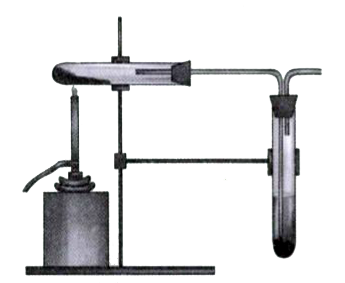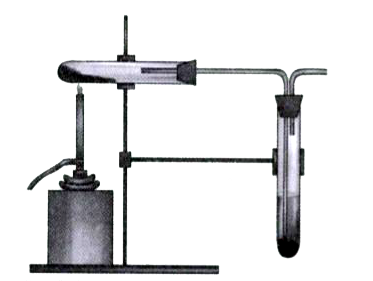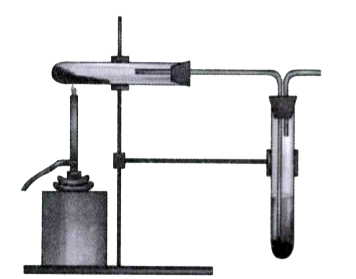Answer is one word.
a. It is the process of conversion of remains of dead plants and trees into coal_______________
b. it is another name for brown coal._____________
c. It is the gaseous residue of coal, during destructive distillation, mainly composed of hydrogen, methane and carbon monoxide._____________
d. Any state of India where coal deposits are found.___________
a. Carbonization
b. Lignite coal
c. Coal gas
d. madhya Pradesh, Tamil Nadu, Odisha
Topper's Solved these Questions
- BOOK - PEARSON IIT JEE FOUNDATIONCHAPTER - COAL AND PETROLEUMEXERCISE - TRACK YOUR LEARNING-I4videos
COAL AND PETROLEUM
- BOOK - PEARSON IIT JEE FOUNDATIONCHAPTER - COAL AND PETROLEUMEXERCISE - TRACK YOUR LEARNING-II10videos
COAL AND PETROLEUM
- BOOK - PEARSON IIT JEE FOUNDATIONCHAPTER - CLASSIFICATION OF MATTEREXERCISE - Concept Application Level - 310videos
CLASSIFICATION OF MATTER
- BOOK - PEARSON IIT JEE FOUNDATIONCHAPTER - COMBUSTION AND FLAME EXERCISE - COMPETITION CORNER30videos
COMBUSTION AND FLAME
Similar Questions
The process of heating coal in the absence of air is called the destructive distallation of coal. Coal contains a number of elements such as carbon, hydrogen, oxygen, nitrogen and sulphur. When coal is heated in the absence of air, a number of products are obtained. A laboratory set up to carry out destructive distillation of coal as shown.

Read the below questions and try to answer them.
Name the main products obtained by the destructive distillation of coal.View SolutionThe process of heating coal in the absence of air is called the destructive distallation of coal. Coal contains a number of elements such as carbon, hydrogen, oxygen, nitrogen and sulphur. When coal is heated in the absence of air, a number of products are obtained. A laboratory set up to carry out destructive distillation of coal as shown.

Read the below questions and try to answer them.
Name the purest of coal.View Solution
Knowledge Check
- Question 1 - Select One
A brief information about a few substances is given as :
X It is the residue left behind after destructive distillation of coal.
Y : It is a mixture of hydrogen, methane, carbon monoxide and other gases.
Z : It contains several carbon compounds which are used to make pesticides, explosives, synthetic fibres, perfumes, etc.
X, Y and Z are respectivelyAKerosene, CNG and ammoniacal liquorBBitumen, coal gas and coal tarCCoke, coal gas and coal tarDPetrol, CNG and bitumen. - Question 2 - Select One
Read the passages given below and answer the questions that follow them:
1. Scientists who study the rocks, minerals, landforms, and the history of the earth can tell what kind of plants and animals lived on the earth a long time ago. These scientists are called geologists. One way that they are able to do this is by the study of fossils. Fossils may be the actual remains of plants or animals, impressions of them in rock, or the tracks of animals as they walked or crawled.
2. Most fossils are formed in the waters covering the continental shelves, in warm, shallow, inland, seas, and in large swamps that covered large parts of the land in post geologic time. When the animals of these waters die, their remains are deposited on the floor of the water body where the fleshy part of the animal decays. The skeletal portion of the body is partially replaced by minerals and other sediments. If this takes place in just the right manner, a fossil is formed. Since rock sediments are involved in the formation of fossils, it is not surprising that one finds many fossils in sedimentary rock layers. Plant fossils are found in the areas that were once swamps. There are four principal kinds of fossils: original remains, replaced remains, moulds and casts, and impressions.
3. In some instances, fossils represent the actual remains of plants and animals. On the shores of the Baltic Sea in Europe, insects of millions of years ago have been found perfectly preserved in the hardened resin of pine trees upon which they crawled. This hardened resin is called Amber. Other examples of original remains are the shells of shellfish which become consolidated or pressed together to form fossil varieties of limestone, and the bones and teeth of dinosaurs and other ancient animals.
4. Another type of original remains may be found at Rancho La Brea, near Los Angeles, California, where there are asphalt pits containing the bones of thousands of animals. They were caught while looking for water or trying to cross the oil-covered lakes of asphalt. As they cried out in their death struggle, their enemies were attracted to the sticky mass and also trapped. Then the bodies sank down into the asphalt.
5. Many fossils no longer contain the original materials of which they were made, although they may look unchanged. Groundwater may replace the lime shells and bones with such hard minerals as silica and iron pyrite. The petrified trees of Arizona are an example of this formation. They were formed when groundwater slowly replaced the decaying wood of these buried trees and silica.
On the basis of your reading of the passage, answer the questions
The most appropriate antonym of the word 'deep’ in para 2 is:AshallowBswampCfossilDfleshy - Question 3 - Select One
A passage is given with 5 questions following it. Read the passage carefully and choose the best answer to each question out of the four alternatives and click the button corresponding to it.
Crude mineral oil comes out of the earth as a thick brown or black liquid with a strong smell. It is a complex mixture of many different substances, each with its own individual qualities. Most of them are combinations of hydrogen and carbon in varying proportions. Such hydrocarbons are also found in other forms such as bitumen, asphalt and natural gas. Mineral oil originates from the carcasses of tiny animals and from plants that live in the sea. Over millions of years, these dead creatures form large deposits under sea-bed and ocean currents cover them with a blanket of sand and silt. As this material hardens, it becomes sedimentary rock and effectively shuts out the oxygen, thus preventing the complete decomposition of the marine deposits underneath. The layers of sedimentary rocks become thicker, and heavier. Their pressure produces heat, which transforms the tiny carcasses into crude oil in a process that is still going on today.
From where does mineral oil originate?AComplex mixture of substancesBCarcasses of tiny animals and plants that live in the seaCFrom lakesDOnly from plants
The process of heating coal in the absence of air is called the destructive distallation of coal. Coal contains a number of elements such as carbon, hydrogen, oxygen, nitrogen and sulphur. When coal is heated in the absence of air, a number of products are obtained. A laboratory set up to carry out destructive distillation of coal as shown.

Read the below questions and try to answer them.
Explain why coal gas is considered an excellent fuel?View SolutionOil is one of the world's major sources of energy. We depend on it as fuel for heating, transport generationof powerl.
For centuries , animal and vegetable oilts have been used for cooking and as a source of artificiaol light. But it is mineral oil which meets most of the world's needs today.
Crude mineral oil comes out of the earth as a thick brown or black liquid with a strong smell. It is a complex mixture of many different sustances. each with its own individual qualities. Most of them are combinations of hydrogen and carbon in varying proportions. Such hydrocarbons are also found in other forms such as bitumen , asphalt and natural gas. Mineral oil originates from the carcasses of tiny animals and from plants that live in the sea. Over millions of years these dead creatures form plants that live in the sea. Over millions of large deposits under the sea bed and ocean currents cover them with a blanket of sand and slit. As this material hardens , it becomes sedimentary rock and effectively shut out the oxygen so preventing the complete decomposition of the marine deposits underneath. The layers of sedimentary rock become thicker and heavier. Their pressure produces heat , which transforms the tiny carcasses into crude oil in a process that it still going on today.
The earth's crust is split into a few huge continental plates which move continuously rather like rafts on a sluggish tide. Geologists call this movements as 'continental drift'.
Rewrite the following sentences in the ways instructed :
(i) Oil is one of the world's major sources of energy .(Rewrite it as a negative sentence without changing its meaning.)
(ii) As this material hardness , it becomes sedimentary rock. (Make it a compound sentence.)
(iii) Geologists call this movements as 'continental drift'.(Frame a 'Wh-question ' to get the underlined part as an answer.)View SolutionGaseous fuels due to their advantages over ther tupes of fuels are becoming highly popular . The advantages fo the fgaseous fuels are as follows :
a. High calorigic value .
b. Do not produce smoke and do not leave ash after combstion .
c. They can flow through pipes and can be ignige at a moment's notic eat any place . No sp-ecial devices are required for their combustion .
i. Coal gas is a good gaseous fuel as it conitains 955 combustible gaseous such as H2,CH4,CO etc , It is obtained buy destructive distillation of coal at 100∘C .
ii. Water gas is a mixture of CO and H2 and is prepared by passing steam over incandescnt coke . The reaction is owever endothermic .
iii. Producer gas , which possesses low calorific value, so prepared by passing aair over red hot coke . It contains mainly nitrogen and CO
iv. Semi-water gas is a mixture of water fas and producer fas .
v. oil gas , which is used in laboratries , is obtained by cracking of kerosene . It is a mixture of hydrocarbon (saturated and unsatureated ) mainly lower hudrocarons .
iv. LPG, which contains C3 and C4 hydrocarbon of the alkane and alkene serties , suppied in cylinders for domestic uses is very populsr these days .
Wich one fo following is a caraking process ?View SolutionGaseous fuels due to their advantages over ther tupes of fuels are becoming highly popular . The advantages fo the fgaseous fuels are as follows :
a. High calorigic value .
b. Do not produce smoke and do not leave ash after combstion .
c. They can flow through pipes and can be ignige at a moment's notic eat any place . No sp-ecial devices are required for their combustion .
i. Coal gas is a good gaseous fuel as it conitains 955 combustible gaseous such as H2,CH4,CO etc , It is obtained buy destructive distillation of coal at 100∘C .
ii. Water gas is a mixture of CO and H2 and is prepared by passing steam over incandescnt coke . The reaction is owever endothermic .
iii. Producer gas , which possesses low calorific value, so prepared by passing aair over red hot coke . It contains mainly nitrogen and CO
iv. Semi-water gas is a mixture of water fas and producer fas .
v. oil gas , which is used in laboratries , is obtained by cracking of kerosene . It is a mixture of hydrocarbon (saturated and unsatureated ) mainly lower hudrocarons .
iv. LPG, which contains C3 and C4 hydrocarbon of the alkane and alkene serties , suppied in cylinders for domestic uses is very populsr these days .
Which one is the best fuel in kitchen ?View SolutionGaseous fuels due to their advantages over ther tupes of fuels are becoming highly popular . The advantages fo the fgaseous fuels are as follows :
a. High calorigic value .
b. Do not produce smoke and do not leave ash after combstion .
c. They can flow through pipes and can be ignige at a moment's notic eat any place . No sp-ecial devices are required for their combustion .
i. Coal gas is a good gaseous fuel as it conitains 955 combustible gaseous such as H2,CH4,CO etc , It is obtained buy destructive distillation of coal at 100∘C .
ii. Water gas is a mixture of CO and H2 and is prepared by passing steam over incandescnt coke . The reaction is owever endothermic .
iii. Producer gas , which possesses low calorific value, so prepared by passing aair over red hot coke . It contains mainly nitrogen and CO
iv. Semi-water gas is a mixture of water fas and producer fas .
v. oil gas , which is used in laboratries , is obtained by cracking of kerosene . It is a mixture of hydrocarbon (saturated and unsatureated ) mainly lower hudrocarons .
iv. LPG, which contains C3 and C4 hydrocarbon of the alkane and alkene serties , suppied in cylinders for domestic uses is very populsr these days .
Which one of following fuels has highest percentage of CO?View Solution

